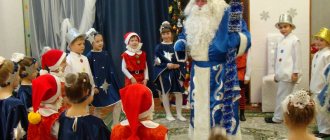Games for speech development for children 6 years old
Games to develop children's speech.
We offer you a series of games aimed at developing a child's speech.
Come up with words
The game promotes the development of imagination and speech. Expands a child's vocabulary
◈ Rules of the game: you need to select and name words starting with a specific letter of the alphabet.
◈ Hang the alphabet on the wall in the nursery and choose letters with your child one by one.
Think faster!
The game promotes the development of attention and speech
Required equipment: ball.
◈ Rules of the game: you throw the child a ball, naming a thematic group, and he must return the ball to you, naming an object from this group. For example: furniture - sofa; berries - strawberries, etc.
◈ This game can be played outside in a group. It's better to roll the ball at home.
One is many
The game promotes the development of attention and speech
Required equipment: ball.
◈ Rules of the game: you throw the ball, naming an object in the singular, the child returns the ball, indicating the plural form. For example: apple - apples, city - cities, letter - letters.
◈ To complicate the game, name objects in the accusative or genitive case, for example:
I don't have an apple. — I don’t have apples.
I see a house. - And I see houses.
Tell me..
The game promotes development, speech, spatial orientation
◈ Tell your child that you came, for example, from another country and know nothing about what surrounds you now. Let your baby become your guide and answer your questions.
◈ Ask about all the objects around you, asking questions, encourage the child to tell a detailed, detailed story: “What is this? Why is this needed? Who uses it? What is it made of? Where does it come from? and so on.
◈ Develop spatial awareness by asking: “What is to our right? Who's coming behind? What passed in front of us?
Make a proposal
The game promotes the development of speech and imagination
◈ Invite your child to make a sentence from the selected words. For example, “river, house, white” - “On the bank of the river there is a house with a white roof” or “In winter, the roofs of houses and rivers become white with snow,” etc.
◈ Start with a small set - the number of words should not be more than three.
◈ Explain to your child that the form of words can be changed, that is, they can be used in the plural and the endings can be changed.
Guess by description
The game promotes the development of speech and imagination
◈ Invite your child to guess the object you wished for based on the description of its features, for example, round, smooth, rubber, bouncing off the ground (ball). Or: round, smooth, sweet, red inside, green outside (watermelon), etc.
◈ Ask your child to make a wish and describe his object.
Guess by action
The game promotes the development of speech and imagination
◈ As in the previous game, you make a guess about something, but describe not the signs, but the actions that the object performs, for example: “Drives along the road, carries passengers, stops at bus stops, refuels with gasoline” (bus)-, “Works in hospital or clinic, treats patients, wears a white coat” (doctor), etc.
◈ Swap roles - the child makes a guess and describes, you guess.
Opposites
The game promotes the development of speech and imagination
◈ Invite your child to come up with pairs of opposite words one by one. For each pair invented, a chip is given out. The one with the most chips at the end of the game wins.
◈ In the first part of the game, pairs are made - nouns, then - adjectives, verbs and adverbs (fire - water, smart - stupid, close - open, high - low).
Good and bad
The game promotes the development of speech and imagination. Develops thinking
◈ Invite your child to identify good and bad traits or actions in fairy tale heroes. For example:
♦ Fairy tale “Cat, rooster and fox”. The rooster woke the cat up for work, cleaned the house, cooked dinner - that’s good. But he did not listen to the cat and looked out the window when the fox called him - this is bad.
♦ Fairy tale “Puss in Boots”: the cat wanted to help his owner - this is good, but for this he deceived everyone - this is bad.
Tops and roots
The game promotes speech development and increases vocabulary
◈ Remember the Russian folk tale “Tops and Roots”. Invite your child to play: you name vegetables whose fruits are in the ground, the baby - vegetables with above-ground fruits.
Find two words
The game helps develop speech and increase vocabulary
◈ Invite your child to find two words hidden in one: leaf fall {leaves, fall), airplane (himself, fly), helicopter (spin, fly), flamethrower {fire, throw), etc.
Write a fairy tale
The game promotes speech development and increases vocabulary
◈ Invite your child to write a story about the adventures of one of his toys. If the task is difficult, help him by asking clarifying questions, suggesting one or another option for developing the action.
◈ To complicate the task, ask to come up with and tell the story of any object from the baby’s environment, for example, a teapot, sofa, etc.
◈ My eldest daughter and I have a favorite heroine - the turtle Zina. We invented it ourselves and before going to bed we come up with different stories about it. This replaces the traditional reading of a bedtime story and helps to easily find a way out of different situations.
Words
The game promotes speech development and increases the child’s vocabulary
◈ This simple game can brighten up your wait with your child in transport, in line, and simply entertain you while out for a walk.
◈ Rules of the game: you and your child take turns pronouncing words out loud so that each next word begins with the letter with which the previous one ends.
◈ To complicate the rules, suggest naming only names or only cities, etc.
Decorate the word
The game promotes the development of imagination and speech, expands vocabulary
◈ Ask the child to select as many definitions as possible for the selected word. For example, tree - what is it? You can fix the number of definitions and name only five for each word
◈ This game is great for a group of children, even if the children are of different ages.
What where When
The game promotes speech development, mastering the grammatical foundations of the Russian language and movement coordination
Required equipment: ball.
◈ When throwing a ball to a child, ask him questions, and he will answer them when he returns the ball. For example:
♦ Where do leaves grow? (On branches or trees.)
♦ Where do fish live? (In the river, in the sea.)
♦ What can you see in the sky at night? (Stars, moon.)
♦ When does the snow melt? (In spring.)
I'm faster
The game promotes speech development, replenishment of vocabulary, development of memory, attention
◈ Stand next to your baby. Choose an object located some distance from you. Explain to your child that the one who reaches this item first will win, but you can only take a step if he names a word from the category you have chosen. For example, everything round (warm, soft), pets, dishes, furniture...
Useful hide and seek
The game promotes the development of attention, helps to study the prepositions under, on, in
◈ Invite your child to play hide and seek with a fairy tale. Make up a short story and ask your child to do what you say. For example: “Once upon a time there was a girl Sofia. One day he and his mother were playing hide and seek. Sofia thought and thought and decided to hide under the table. Mom looks and her daughter is gone. Where is she? Maybe under the sofa? I looked and she wasn’t there. Or maybe under a chair? And there isn't. Oh, that’s where it is - under the table.” Next you tell how the girl hid in the closet, climbed onto a chair and hid.
◈ You can take any toy and play hide and seek with it. Then switch roles - let the child hide the toy and tell the story.
Think and name
◈ Invite your child to rename some objects. You can rename it based on the functions of objects, for example: “The rain is dripping, so we’ll call it a digger. The shovel digs, so we call it a digger. Watering can - watering can. Legs are walkers,” etc.
Similar articles:
Games to develop speech for 5 year old children
Outdoor games for children 6 years old
Outdoor games for children from 6 to 7 years old
Development of correct speech in a 3- and 4-year-old child
Math games for a 6 year old child
Progress of the game: offer to answer the questions.
Lexical material:
noise of the city - noise (what)
–
(urban)
;
lantern on the street - lantern (what kind)
– …;
park bench - bench (what kind)
– …;
guests of the city - guests (which ones)
– …
sign by the road - sign (what)
— ….
Game "Say the other way around"
Goal: compare objects and phenomena according to temporal and spatial relationships (by size, color and quality, selecting antonyms.
The norm of speech development of children of the fifth year of life
The state of children's speech at the age of four to five years can be very different: from perfect command of the capabilities of their native language to very slurred statements with a meager vocabulary and a lot of grammatical errors.
Guidelines that you can rely on when analyzing the state of children’s speech:
- a child of five years of age uses words exactly according to their meaning;
- in addition to the main parts of speech, he actively uses adjectives, adverbs, and pronouns;
- children can quite fully describe toys, objects, pictures;
- most sounds are pronounced clearly and correctly, although the articulation of [l] and [r] may not yet be mastered;
- he is able to control the volume of his speech and can speak in a whisper;
- the pace of statements is average, without slowness or excessive haste;
- When reciting poetry and telling fairy tales, children use expressive intonation.
In the fifth year of life, children can already speak faster and slower, pronounce words quieter and louder, and notice these nuances in the speech of other people. Kids add an interesting emotional color to their statements and use intonation to express their messages. This allows them to recite poems they have learned by heart with greater artistry.
The main quality of children's speech at this age is its coherence and consistency in the presentation of thoughts.
Diagnosis of speech disorders
To check on your own how things are going with speech disorders in a child who speaks incomprehensibly, you can conduct several simple tests. To study vocabulary, he is asked to name animals, seasons, dishes, toys, furniture from pictures.
Children are asked to name objects, phenomena, qualities of objects, to carry out an assignment (draw something, bring an object or toy). To find out how they can change words, they offer the following tasks:
- form the plural (nose – noses, chair – chairs),
- offer to count objects, determining how he coordinates nouns with numerals (one book, two books, etc.);
- say “affectionately” (doll - doll, bed - crib).
To determine the level of development of phrasal speech, children are asked to complete a sentence started by an adult: “The boy... is playing ball.” For this, pictures with different scenes are used. When observing a child’s speech in everyday life, you need to note for yourself which parts of speech the child uses and evaluate his ability to correctly construct a phrase.
To examine the syllabic structure of a word, the child is offered verbal tasks without using pictures: repeat syllables from different consonants and vowels (lo-se-ku, pi-ka-chu), syllables from the same consonants and different vowels (da-doo-dy-do) , from the same vowels and different consonants (la-ma-ka-sa). To understand whether the child feels the rhythm of speech, they tap the rhythm of a simple word and ask him to repeat it in the same way.
Prevention of speech delay
The formation of a senior preschooler’s perfect speech is influenced by his living conditions, the characteristics of his parents’ upbringing style, and, most importantly, the efforts of caring adults. To avoid finding yourself on the threshold of school in a situation where a child has discovered numerous speech disorders and there is no time to correct them, you need to take care in advance of the harmonious development of the child’s speech.
To solve this problem, close communication between children and adults is of great importance. Walking together, doing creative work, looking at book illustrations with a parallel discussion of what they saw and felt. This work will give a powerful impetus to the development of the baby’s speech. It is very valuable to learn and use such rich material as counting rhymes, tongue twisters, poems, riddles, sayings, nursery rhymes, and proverbs. All words that children do not understand need to be explained and ensure that they are used correctly.
Reading children's literature should be accompanied by a conversation about the actions of the characters and an explanation of incomprehensible words. When memorizing poetic works, it is very useful to replenish a child’s vocabulary by drawing his attention to the figures of speech used by the author. “A dark forest that covered itself with a wonderful hat...” “What hat did the poet write about?” “And fell asleep under her quietly, soundly...” “Do you think the forest can fall asleep?” “How do you understand the word restlessly?”
In order to fully prepare for schooling, a child of five to six years old must be able to coherently express his thoughts and construct logical, complete statements. It is important to correct deficiencies in sound pronunciation in a timely manner, to teach children to use their voice and means of expression. If children receive a lot of positive information from the outside world and from fiction that they can discuss with adults, this greatly stimulates children's speech development.








